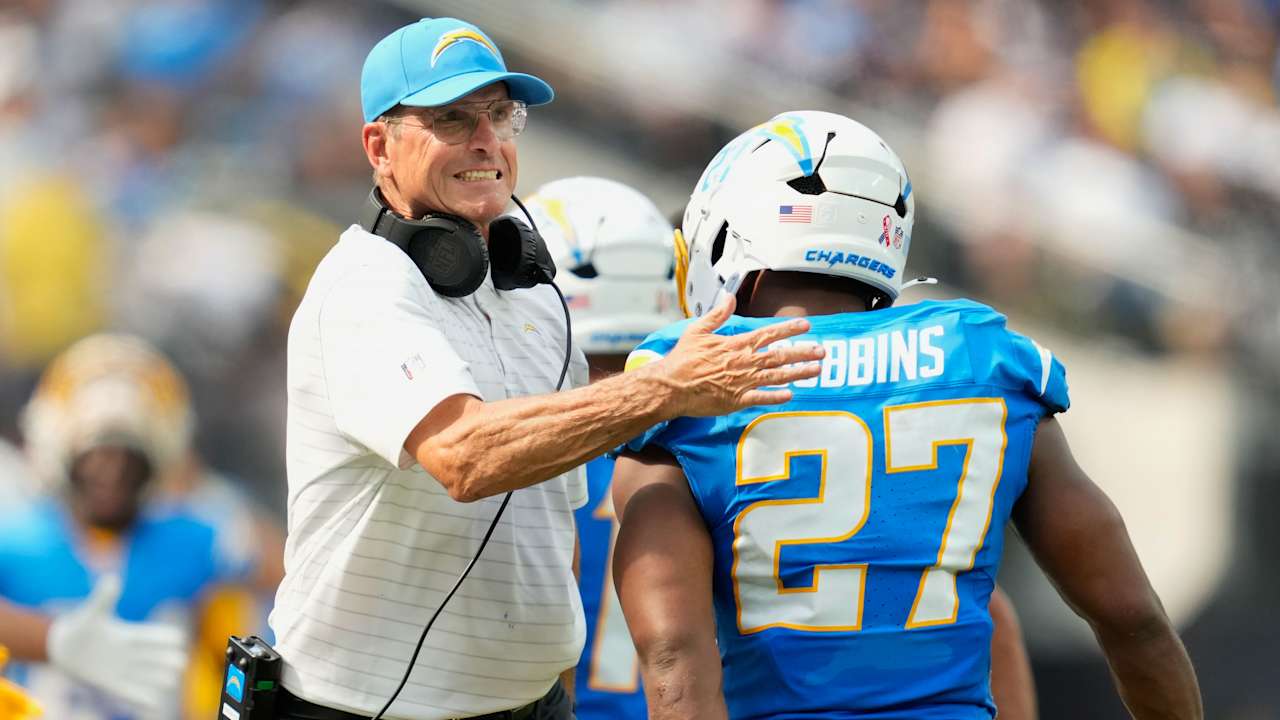The 60-year-old head coach used a ground-and-pound approach to revive the University of San Diego, Stanford and the Niners before rebuilding Michigan into a true power. So it was no surprise that in Harbaugh’s debut with the team last Sunday, the Chargers used a run-heavy game plan to beat the Raiders 22-10. Los Angeles finished the game with more rushing yards (176) than passing yards (140). JK Dobbins led the way with 135 yards and a touchdown on just 10 carries, while Justin Herbert completed 17 of his 26 passes for a modest 144 yards and a touchdown.
Although it’s just a one-game example, the Bolts’ winning formula is similar to the strategy that helped Harbaugh post a 44-19-1 regular-season record during his first coaching tenure in the league. The former NFL quarterback believes in building his offense around the O-line and the running game because it helps every part of the team win in the trenches.
“The offensive line is important to me,” Harbaugh told reporters at the league’s annual meeting in March. “If I asked you the question, what position group does not depend on any other position group to be good, but every other position group depends on it, them to be good – which position group is that? Offensive Line. You don’t rely on another position group to be good, but every other position group relies on the offensive line to be good. And then the D-Line, they’re going to be the ones arguing against that, “Yeah, we don’t need a good offensive line.” … “And you? Do you like it when the offense has a 12-play drive and field position?” … “Yes – oh, yes. OK, you’re right.” “
Harbaugh has always focused his rebuilding efforts on the offensive line. At Stanford, he regularly put seven or eight linemen on the field in the old-fashioned I-formation to subdue opponents. That formula turned a struggling Stanford into a force, with the Cardinal playing smashmouth football and beating highly regarded programs like USC. After working his magic in San Francisco with a stellar offensive line—letting quarterbacks Alex Smith and Colin Kaepernick shine and leading the 49ers to three consecutive NFC Championship Game appearances and a Super Bowl—Harbaugh built the Wolverines into a powerhouse behind an offensive line that won two consecutive Joe Moore Awards (given to the best O-line in college football). The coach had some talented playmakers on the team during his college years (see: first-round picks Andrew Luck and JJ McCarthy), but clearly believes in a nostalgic approach where the quarterback is not the main role, but a side dish.
Given Harbaugh’s success in building elite teams at the college and professional levels without putting the quarterback as the focal point of the offense, it’s only natural that he would take that approach with the Chargers, despite having a highly regarded quarterback in Herbert. Harbaugh believes the offensive line is the tip of the spear, and builds his attack around the top five blockers on the roster.
Los Angeles’ new head coach understands the impact of the offensive line on the signal-caller’s performance. With a dominant O-line that excels at run blocking and pass protection, the game becomes easier for the man under center. When you hand the ball off to a productive running back who averages 4-5 yards per run, the defense eventually adapts by filling the box and inevitably missing one-on-one coverage. In addition, the illusions created by a complementary play-action passing game lead to larger throwing windows and wide-open receivers on the field. When the quarterback masters the slick ball-handling maneuvers that lure linebackers and safeties to the line of scrimmage, the field opens up for receivers attacking gaps at medium depth (10-19 yards). And with the increased use of quarters coverage throughout the NFL, safeties are forced to attack the line of scrimmage from deep to accomplish their run gap duties. Thus, the play-action passing deception can lead to big plays on post routes and deep overs.

